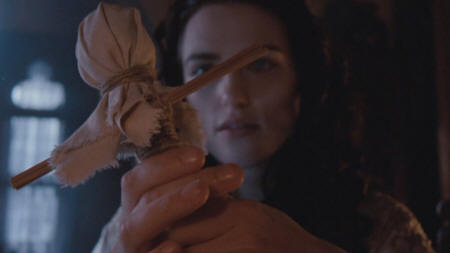
By Lynn and Patti
Part 1: What is a Poppet? And Why Would I Want to Play With Dolls Anyway?
A poppet is, for lack of a better term, a voodoo doll. It is one of the most commonly used implements in sympathetic magick, which entails the idea that “like creates like”. Thus, if you create a poppet of a person, anything to do to that poppet will affect the person it represents. Poppets are especially useful for spells that attract (or keep) a lover, heal, or banish. They can be used anytime you need to affect a specific person.
Usually, a poppet is made out of cloth, but it can also be made out of clay, wood, wax, or other materials. It is can be filled with herbs consistent to the purpose of the spell and a few personal items (called taglocks, but more on them later) that tie the subject of the spell to the doll. Of course, you can always use your creativity and add your own stuff. If you don’t feel like using all those herbs, you could add some “filler”, such as cotton.
Once you have your poppet, you’ll need to tie the doll to the person you want to be represented by it. After that, it’s completely up to you to decide how involved the spell should be. It could be for a week, or over in minutes. It’s your decision.
So exactly how can a poppet be used in a working? Here’s an example. Say you wanted to banish a certain person from your life. You could make your poppet out of black cloth, and possibly put rue, birch, and/or garlic in it. Then you could bind his hands to stop him from meddling and toss him in a river or in a current that would carry the poppet away from you, which would symbolize him being carried away from you and your life.
Poppets are simple and fun. Nearly everyone has craft supplies lying around their house, so grab ‘em and get makin’! And remember to have fun!
Part 2: Worldwide Poppetry - More Than Just Pins in a Doll
When most people think of a poppet, they automatically think of the Voodoo doll. While the Voodoo religion is certainly the most well-known culture to use the poppet, the use of sympathetic magick goes back thousands of years. In fact, in 1100 BCE, the many enemies of Pharaoh Ramses III of Egypt (which included the women of his harem and a treasury official) used wax images of him to bring about his death..(1)
The ancient Greeks often used sympathetic magick in love or defensive spells. Christopher Faraone, Professor of Classical Languages and Literatures at the University of Chicago, is one of the foremost authorities on Greek magick today. Faraone states that Greek poppets, called Kolossoi, were sometimes used to restrain a ghost or even a dangerous deity. They could also be used to bind two lovers together.(2)
The Greek tragedian Theocritus refers to melting and burning wax dolls in Idyll 2, The Witch (Pharmakeutria), which was written around 270 b.c.(3) He describes the ways in which Simaetha, who has been dumped by her lover, Delphis, attempts to lure him back to her with magic. At the same time, she tries to make him forget any woman who might be a potential rival. Simaetha was quite a busy girl.
The idea of wax dolls has carried on throughout the centuries. When Caroline of Brunswick, Princess of Wales, was married to a perfectly awful gentleman who would become King George IV, she apparently spent many hours forming wax dolls of her husband and jabbing them with pins. There is no evidence as to the effect this may have had on George, but when Caroline decided to scamper off to a villa in Italy and shack up with her Italian lover, George didn’t protest. The royal couple remained married but lived separately until Caroline’s death in 1821.(4)
In West African magick, a doll called a fetish is used. The doll is actually possessed by spirits, and represents the spirit to the doll’s owner. The fetish contains magickal power, and is carried by its owner either on the body or as an amulet. Slave owners in North America were permitted to hand out a death sentence to anyone found in possession of a fetish.(5) Small wonder, considering that the owners didn’t understand anything about African culture – and subsequently feared it.
In Voodoo itself, or Vodun, the use of poppet magick became popular in New Orleans after the end of the Civil War, although sources disagree as to whether poppets are used at all in Haiti, the home of the Vodun religion.
The Voodoo Museum of New Orleans even stocks a variety of dolls in their gift shop. This appears to be a bone of contention among practitioners, some of whom are trying to get away from the “serpent rite and pins-in-the-doll” rituals.(6)
Raymond Buckland recommends the use of poppets in healing spells, and maintains that even the sticking of pins in the poppet can be used for good. He states that if treating someone who experiences back pain, the pins can be inserted in the poppet’s back. After concentrating on a healing ritual, the pins – representing the pain itself – would slowly be drawn out of the poppet. In other words, the sharp pain would be drawn out of the target’s body.(7)
Regardless of whether you use a cloth doll, a wooden fetish, or a man-shaped glob of wax, remember that poppets have a long tradition behind them – a tradition that is influence by the magickal practices of many cultures. If you find yourself drawn to a particular culture’s pantheon of deities, by all means use methods that honor them. Treat your poppets well, and they will do the same for you.
No comments:
Post a Comment